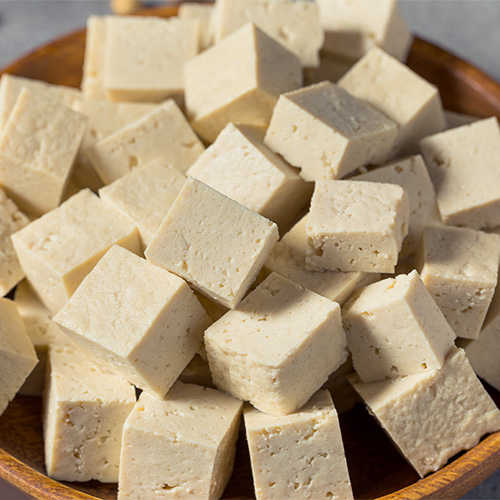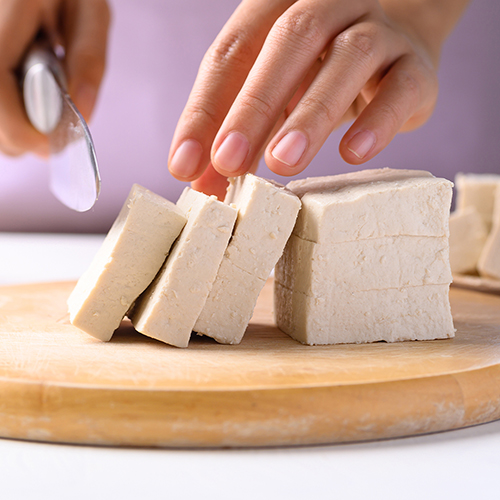Tofu dishes have been growing in popularity as consumers look for tasty plant-based dishes that also pack a lot of protein. The only problem is that not all cooks know how to prep their tofu for the best flavor and texture. Thankfully, it’s not as complicated as you might think! Pressing tofu to remove moisture is a key step to achieving the satisfying chewiness that customers love. We’ll teach you the easiest way to get the water out of your tofu so you can take your vegan menu options to the next level.
Shop Bulk TofuHow to Press Tofu Without A Press
Watch our quick video to learn how to press all the liquid out of your tofu:
Do You Need to Press Tofu?

If you've been skipping the pressing step, you may have found that your tofu tastes bland and has a mushy texture. This can be avoided with some simple prep work. While you don't need to press the water out of tofu, it does offer several advantages:
- Improves Texture - Pressing tofu helps to remove excess moisture, which is crucial if you want to achieve a firmer and chewier texture. When tofu is properly pressed, it becomes less spongy and holds its shape better when cooked. This is especially important when you're looking to create tofu dishes with a meaty texture.
- Makes it Crispier - Pressing tofu is the secret to achieving that coveted crispy exterior. By removing the excess moisture, the tofu browns more easily, allowing it to develop a golden crust when cooked. Chemists refer to the browning of foods as the Maillard reaction, and it's the reason that crispy, seared, or charred foods have a more pronounced umami flavor. Tofu is no exception!
- Absorbs Flavors - Tofu is like a blank canvas that readily absorbs flavors. By pressing tofu, you create more space for it to soak up marinades, spices, and seasonings, resulting in a more flavorful end product. Whether you're marinating it in a tangy teriyaki sauce or seasoning it with a blend of aromatic spices, pressed tofu will elevate your dish in terms of taste.
- Reduces Cooking Time - By pressing tofu, you can actually reduce its cooking time. Removing excess moisture allows the tofu to cook more evenly and quickly, saving you precious minutes in the kitchen. This is especially beneficial when you're preparing stir-fries or other quick-cooking dishes.
How to Press Tofu Before Cooking

Before you run out and purchase a tofu press, try our easy method. You can strain the water out of tofu with kitchen tools you already have on hand. This technique also works for pressing tofu in bulk. Grab two large sheet pans, a cooling rack, and a clean kitchen towel. You'll also need a heavy object, like a large can or container of food.
- Drain the tofu - Remove the tofu from its packaging and drain any excess liquid. Gently pat it dry with a paper towel or a clean kitchen towel. You want to get the tofu as dry as possible to achieve browning.
- Cut the tofu - Slice the tofu into evenly sized pieces or cubes, depending on your recipe. This will help the tofu press more evenly.
- Prepare a sheet pan - Place a cooling rack on top of a sheet pan and add the tofu pieces to the rack in one even layer. This allows the water to drain through the cooling rack and collect in the pan below.
- Find a heavy object - Cover the tofu with a clean kitchen towel (or paper towels). Take the second sheet pan and place it over the kitchen towel. Now you'll need to find a heavy object or two (like a large can) to put on top of the second sheet pan to weigh it down. The weight will help squeeze out the excess moisture from the tofu.
- Wait patiently - Press the tofu for 30 minutes. The longer you press it, the firmer it will become. If you have the time, you can even leave it pressed in the refrigerator for a few hours or overnight for maximum results.
- Use the pressed tofu - Once the pressing time is up, remove the heavy object and the towels from the tofu. You can now cook with the tofu or freeze it to give it an extra chewy texture. Whether you're stir-frying, grilling, or baking it, the pressed tofu will have a firmer texture and absorb flavors more effectively.
Note: Keep in mind that tofu is considered a TCS food, which means that it should be handled with care to remain food-safe. While pressing, don't leave the tofu out of refrigeration for more than two hours. Use the pressed tofu within 3 or 4 days. When cooked, the tofu must reach a safe internal temperature of at least 135 degrees Fahrenheit.
What If You Don't Have Time to Press Tofu?
Sometimes you don't have the time to wait for your tofu to be pressed. If you want to skip this step, there are a couple of things you can do to prevent soggy tofu. Try these alternatives:
- Pre-pressed tofu - The easiest trick is to buy pre-pressed tofu! This tofu comes out of the package with a dry, dense texture that's ready to cook without any pressing needed. It's a huge time-saver and yields delicious results.
- Dry the surface - If you need to get the tofu cooking immediately, the blotting technique will help to remove liquid from the surface. Cut the tofu into pieces and use a paper towel to blot away as much moisture as possible. It's not perfect, but it helps!
- Double cooking method - Instead of cooking the tofu with your other ingredients, flash cook it lightly with oil to remove moisture, then set it aside. In the same skillet, saute the vegetables or stir-fry ingredients. Once they're cooked, add the tofu back into the skillet and continue cooking for a few more minutes. This second round of cooking will help remove additional moisture from the tofu and give it a firmer texture.
Tofu Pressing FAQ
If you're still looking for more info on pressing the liquid out of tofu, check out the common questions below:
Do All Types of Tofu Need to Be Pressed?
The answer is no, not all types of tofu can be pressed. Silken tofu, for example, is a delicate and custard-like variety that does not have the same firmness as other types. Due to its high water content and soft texture, pressing silken tofu will not yield the desired results.
What Types of Tofu Can Be Pressed?
Generally, firm and extra-firm tofu are the best candidates for pressing. These types of tofu have a higher protein content and a denser texture, which can be improved by pressing out the moisture.
Should You Freeze Tofu Before or After Pressing?
When it comes to pressing tofu, there's often a debate about whether to freeze it before or after pressing. Freezing tofu before pressing can result in a firmer and chewier texture while freezing tofu after pressing helps it retain its shape and absorb flavors better. Experiment with both methods to find what works best for your culinary creations.
Tofu is a versatile and nutritious plant-based protein that has gained popularity in recent years. Whether you're a seasoned chef or a home cook, learning how to press tofu can take your culinary skills to the next level. Pressing tofu is a crucial step that helps to improve its texture and enhance its ability to absorb flavors. By removing excess moisture, you'll be left with tofu that is firm, crispy, and ready to be coated in the sauce of your choice.



